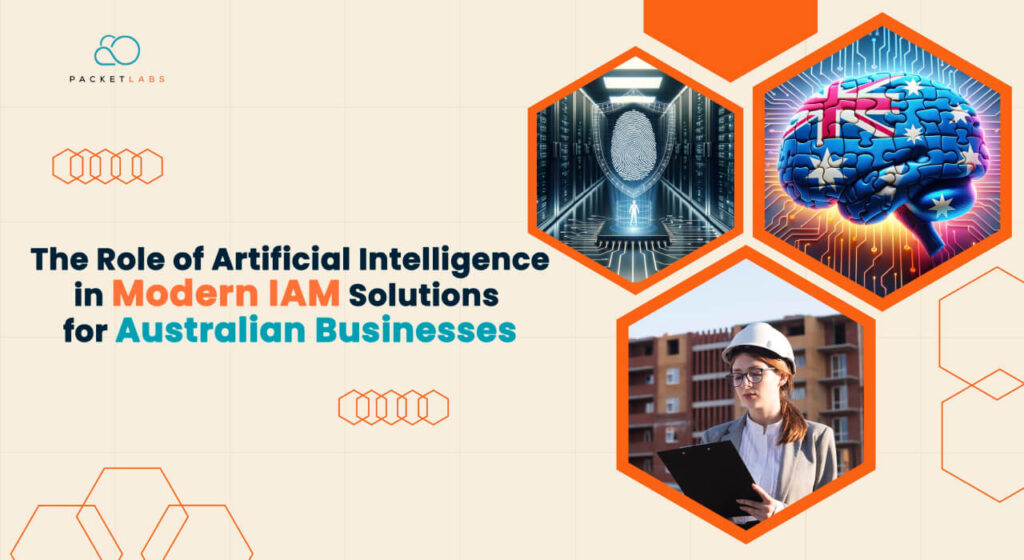
Identity and Access Management (IAM) is a critical framework for ensuring that the right individuals have access to the appropriate resources within an organisation. By managing user identities and controlling access permissions, IAM helps protect sensitive data and maintain compliance with regulatory standards. In recent years, artificial intelligence (AI) and machine learning have become integral to enhancing IAM systems, providing advanced capabilities for threat detection, user behaviour analysis, and automated identity governance. This article explores the transformative impact of AI-driven IAM solutions on Australian businesses, which face unique security challenges and regulatory requirements. As Australian companies continue to digitalise their operations, leveraging AI in IAM can significantly improve security, efficiency, and user experience, ensuring robust protection against increasingly sophisticated cyber threats.
Overview of IAM

Identity and Access Management (IAM) is a systematic framework designed to manage digital identities and regulate access to an organisation’s resources. Its core functions include authentication, authorisation, and user lifecycle management, ensuring that users are accurately identified and granted appropriate access levels based on their roles and responsibilities. IAM is essential for maintaining robust security and operational efficiency by preventing unauthorised access and reducing the risk of data breaches.
IAM’s importance lies in its ability to enforce security policies consistently and streamline access control processes, thereby enhancing productivity and compliance with regulatory requirements. A well-implemented IAM system minimises the risk of internal and external threats by ensuring that only authorised users can access sensitive information and systems.
Historically, IAM began with basic password management and evolved to include more sophisticated methods such as multi-factor authentication (MFA) and single sign-on (SSO). With the advent of cloud computing and mobile technologies, IAM solutions have further advanced to accommodate complex environments, offering features like identity federation and adaptive authentication. Today, the integration of AI and machine learning into IAM represents the latest evolution, providing enhanced capabilities for threat detection, automated provisioning, and user behaviour analysis, which are crucial for addressing modern security challenges faced by Australian businesses.
The Intersection of AI and IAM

Artificial intelligence (AI) and machine learning technologies are increasingly being integrated into Identity and Access Management (IAM) solutions, revolutionising how organisations secure and manage digital identities. AI-driven IAM systems leverage advanced algorithms to analyse vast amounts of data, enabling more precise and dynamic access controls. By continuously learning from user behaviour patterns, these systems can detect anomalies and potential threats in real-time, significantly enhancing security.
The integration of AI in IAM offers several potential benefits. Enhanced security is achieved through sophisticated anomaly detection, which can identify unusual activities and trigger immediate responses to mitigate risks. Improved user experience is another advantage, as AI-powered systems can provide seamless authentication processes, such as biometric authentication, reducing the reliance on traditional passwords. Additionally, AI facilitates operational efficiency by automating provisioning and de-provisioning processes, ensuring that users have timely access to the necessary resources while minimising administrative burdens.
Relevant technologies like biometric authentication use unique physical characteristics, such as fingerprints or facial recognition, to verify identities accurately. Anomaly detection leverages machine learning to identify deviations from typical behaviour, enabling proactive security measures. Automated provisioning streamlines the assignment and revocation of access rights, reducing the risk of human error and enhancing overall IAM effectiveness. For Australian businesses, adopting AI-driven IAM solutions is crucial for maintaining robust security and operational efficiency in an increasingly complex digital landscape.
Benefits of AI in IAM for Australian Businesses
Enhanced Security

AI-driven IAM solutions significantly bolster security by detecting and mitigating threats more swiftly and accurately than traditional methods. Utilising advanced machine learning algorithms, these systems can analyse vast datasets in real-time, identifying anomalies and suspicious activities that might indicate security breaches. For example, AI can detect unusual login patterns or access requests, flagging potential insider threats or compromised accounts. This proactive approach enables organisations to respond to threats before they escalate, reducing the likelihood of data breaches and ensuring the integrity of sensitive information.
Improved User Experience

AI-driven IAM solutions offer a seamless and secure user experience by leveraging advanced authentication methods such as biometric authentication and adaptive authentication. Biometric authentication, which uses unique physical characteristics like fingerprints or facial recognition, eliminates the need for complex passwords, making access more convenient and secure. Adaptive authentication dynamically adjusts security measures based on the risk level of a particular access attempt, providing robust protection without compromising user convenience. This results in a frictionless experience for users, who can access necessary resources quickly and securely, enhancing overall productivity.
Operational Efficiency

AI significantly streamlines identity management processes, reducing the burden on IT departments. Automated provisioning and de-provisioning ensure that users are granted the appropriate access rights promptly, minimising the risk of human error and improving compliance with security policies. Additionally, AI can automate routine IAM tasks, such as password resets and access reviews, freeing IT staff to focus on more strategic initiatives. This operational efficiency not only saves time and resources but also ensures that IAM processes are consistently applied across the organisation, further enhancing security and compliance.
Comparison of Traditional IAM and AI-driven IAM Solutions
| Feature | Traditional IAM | AI-driven IAM |
|---|---|---|
| Threat Detection | Reactive and manual | Proactive and automated |
| Authentication Methods | Password-based | Biometric and adaptive |
| Provisioning and De-provisioning | Manual and error-prone | Automated and accurate |
| User Experience | Often cumbersome | Seamless and secure |
| Operational Efficiency | Labour-intensive | Streamlined and automated |
By adopting AI-driven IAM solutions, Australian businesses can achieve enhanced security, improved user experiences, and greater operational efficiency, positioning themselves to effectively manage identity and access in an increasingly digital and threat-prone environment.
Case Studies of AI in IAM Implementation

Several Australian businesses have successfully implemented AI-driven IAM solutions, demonstrating significant benefits across various industries. For instance, a leading Australian bank adopted an AI-based IAM system to enhance its cybersecurity measures. The system’s ability to analyse user behaviour and detect anomalies in real-time allowed the bank to prevent potential fraud and secure sensitive financial data. As James O’Connor, the bank’s Chief Information Security Officer, stated, “AI has revolutionised our approach to identity management, enabling us to detect threats faster and more accurately than ever before.”
In the healthcare sector, a prominent hospital in Sydney implemented an AI-driven IAM solution to manage access to patient records. The system’s automated provisioning ensured that healthcare professionals had timely access to necessary information, while stringent authentication measures protected patient privacy. Dr. Emily Rogers, the hospital’s IT Director, noted, “AI has significantly improved our operational efficiency and patient data security, allowing us to focus more on providing quality care.”
The government sector has also seen notable successes. A state government agency integrated AI into its IAM framework to manage access to a vast array of public services. The AI-driven system streamlined identity verification processes, reducing the time and effort required for citizens to access services securely. According to Mark Bennett, the agency’s Director of IT Services, “The implementation of AI in our IAM system has greatly enhanced our service delivery, ensuring secure and efficient access for all stakeholders.”
These case studies highlight the transformative impact of AI in IAM across different sectors. Flowcharts illustrating the implementation process and outcomes can provide a clearer understanding of these successes. For instance, a flowchart could depict the stages of integrating AI into an IAM system, from initial assessment and planning to deployment and ongoing monitoring. Another flowchart could showcase the outcomes, such as reduced fraud incidents in finance, improved data security in healthcare, and enhanced service efficiency in government.
By examining these real-world examples, Australian businesses can gain valuable insights into the potential of AI-driven IAM solutions, inspiring confidence in their ability to enhance security and operational efficiency across various industries.
Challenges and Considerations

Integrating AI with Identity and Access Management (IAM) presents several challenges that businesses must address to ensure successful implementation. Privacy concerns are paramount, as AI systems often require access to vast amounts of personal data to function effectively. Ensuring that this data is handled securely and in compliance with privacy laws is crucial to maintaining trust and avoiding legal repercussions. Data security is another significant concern; AI-driven IAM systems must be protected against cyber-attacks that could compromise sensitive information.
The costs associated with implementing AI in IAM can be substantial. These include not only the initial investment in AI technologies but also ongoing expenses for maintenance, updates, and personnel training. Organisations must carefully assess their budgets and consider the long-term financial implications of adopting AI-driven IAM solutions.
Regulatory compliance is a critical factor for Australian businesses. Adhering to standards such as the Privacy Act 1988 and the Australian Privacy Principles (APPs) is essential. Companies must ensure that their AI systems are designed and operated in a manner that meets these regulatory requirements. This often involves conducting regular audits and assessments to verify compliance.
Continuous monitoring and updating of AI models are vital to maintaining their effectiveness. AI systems must adapt to evolving threats and changing user behaviours, necessitating ongoing training and refinement of algorithms. Businesses should establish robust monitoring frameworks to track the performance of their AI-driven IAM systems and implement updates as needed to address new security challenges.
By recognising and addressing these challenges, Australian businesses can effectively integrate AI into their IAM frameworks, enhancing security and operational efficiency while maintaining compliance with regulatory standards.
Future Trends in AI and IAM

Future developments in AI and IAM technologies promise to further revolutionise identity management for Australian businesses. Advances in machine learning algorithms will enhance the precision and efficiency of threat detection, making IAM systems even more robust. Predictive analytics will play a significant role, allowing organisations to anticipate and mitigate potential security breaches before they occur.
Emerging technologies such as blockchain are poised to intersect with AI and IAM, offering decentralised and tamper-proof identity verification methods. Blockchain can provide a secure and transparent framework for managing digital identities, complementing AI’s capabilities in real-time analysis and decision-making. This synergy could lead to the development of highly secure and efficient IAM solutions, reducing the risk of data breaches and enhancing trust.
Additionally, the integration of AI with Internet of Things (IoT) devices will necessitate advanced IAM solutions to manage the increasing number of connected devices securely. As these technologies evolve, Australian businesses will benefit from more sophisticated, scalable, and secure identity management systems, ensuring robust protection and streamlined operations.
This article has explored the transformative role of AI in modern IAM solutions, highlighting its benefits in enhancing security, improving user experience, and streamlining operations. AI-driven IAM systems offer advanced capabilities in threat detection, biometric authentication, and automated provisioning, making them indispensable for contemporary identity management. For Australian businesses, adopting these innovative solutions is crucial to maintaining robust security and operational efficiency in an increasingly complex digital environment. By embracing AI-driven IAM technologies, organisations can stay ahead of emerging threats and ensure secure, efficient access management, thereby safeguarding their assets and reputation.
